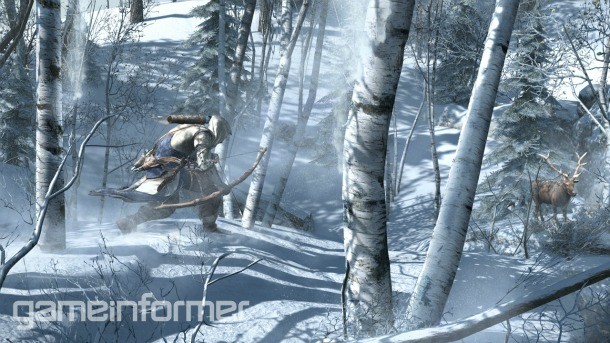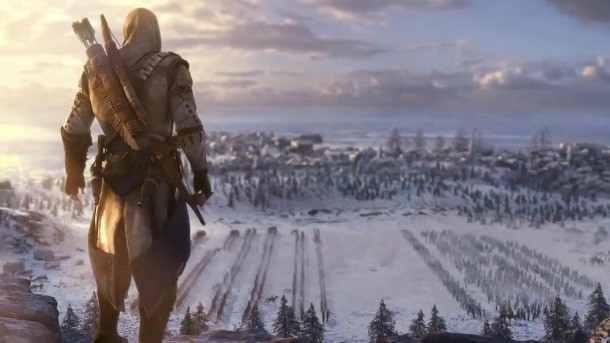Please support Game Informer. Print magazine subscriptions are less than $2 per issue
Exploring The Assassin's Creed III Frontier

One of the most rewarding experiences of any Assassin’s Creed game is roaming through recreations of some of history’s most picturesque cities. From the dust-caked streets of Jerusalem to the Byzantine marvels of Constantinople, the experience of exploring the neighborhoods once inhabited by the likes of Leonardo da Vinci and Niccolo Machiavelli is a thrill for history buffs. With Assassin’s Creed III taking place before, during, and after the American Revolution, players will soon get the chance to explore the rapidly evolving hub cities of Boston and New York City, but the real draw of the New World setting is the untamed wilderness that comprised the majority of the continent.
This isn’t the first time players have been given access to the regions between cities in Assassin’s Creed. The original game featured the Kingdom, an open landscape that connected the cities of Acre, Masyaf, Damascus, and Jerusalem. The problem was that all you could do in this area was get chased by guards and track down flags. Ubisoft Montreal is aware that in the post Red Dead Redemption world, the bar for open expanses of explorable terrain is high. In Assassin’s Creed III, the studio plans to pack the Frontier with several activities.
For all intents and purposes, the Frontier serves as the “third city” in the game. Whereas no missions took place in the open area between the cities in the original game, the Frontier is home to roughly 30 percent of the story missions in Assassin’s Creed III. It’s also a huge expanse of land.
“The map of the Frontier is 1.5 times bigger than the entire map of Brotherhood,” says creative director Alex Hutchinson. “It has this sense of exploration about it, which I don’t think we’ve had before. That notion of you versus the wilderness.”
The Frontier is a hyper-realized version of the American Northeast filled with dense forest, fields, farming regions, lakes, mountains, cliffs, caves, and recognizable landmarks. The countryside is also home to several smaller Native American and European settlements, including logging camps, mills, trading posts, protagonist Conner’s Mohawk village Valley Forge, and the towns of Lexington, Concord, and Charlestown. Ubisoft says there will be no load times when you’re exploring the Frontier, ensuring a seamless experience until you return to New York or Boston.
These small towns and war locations will also transform as time passes and the fighting takes its toll. Whereas Valley Forge may be filled with troops in anticipation for the battle, if you come back after the fight all you may see are a few lingering injured soldiers and some abandoned tents.
Into The Great Wide Open
Introducing a region so large raises a question – how do players get around the Frontier? Ubisoft Montreal designed it with the intention that players can go anywhere on foot, but you have other, more entertaining options. “It should be as fun to run around the wilderness as the city,” Hutchinson says.
Tree traversal is Connor’s most impressive method of navigation. Once he’s up in the branches, he can move swiftly from tree to tree, an effective tool for moving undetected past patrolling soldiers below. To build this functionality, Ubisoft Montreal borrowed the RealTree technology from Far Cry 2 and tweaked it to make the trees into a gameplay platform. Building fully interactive objects with branches, knobs, and V-shaped trunks that allow players to travel in any direction at any time wasn’t easy. “I think it’s fair to say that trees were not the favorite topic of our technical directors,” Hutchinson says with a laugh.
The engineering difficulties look like they were worth the trouble. In the demo we watched, Connor moves effortlessly while running, jumping, and monkey barring across tree branches and around trunks. When necessary, the camera pans to show the player where to go when navigational options become scarce. Within the frontier, gigantic landmark trees serve as the wilderness equivalent to the city towers. After working your way to the top, you will be rewarded with a breathtaking vista of the New England countryside.
For those times where you want to get to your destination quickly, you can jump on a horse instead of vaulting through the trees. While the developers didn’t go to the crazy lengths that Rockstar did with motion capturing a horse, Ubisoft says it did its due diligence developing the AI so the animal operates with a mind of its own. The horse knows when it needs to veer around trees, and is smart enough to stop if you try to run him off a dangerous cliff. Horses are also capable of traversing uneven terrain, but there are some extreme areas they will avoid as well.

Weathering The Seasons
Given the northeastern setting and the long passage of time from the beginning to the end of Assassin’s Creed III, Ubisoft Montreal is changing up the environments by cycling players through the seasons. Players may not think twice about traversing the forests and countryside on foot during the warm summer months, but once the snow falls everything changes. Lakes freeze, giving you a new path across the Frontier, and snowfall makes traversing the wilderness more treacherous.
“We wanted winter to matter,” Hutchinson says. “If you lived in the northeast of America in this period, winter is scary. If you’re not prepared for winter, you will die.”
Depending on whether the snow is deep or shallow, it changes the way you interact with the space. When the drifts are high the snow slows you down a lot and moving through the tree branches becomes the preferred method of traversal.
The snow also poses a problem for NPCs, which can give Connor the upper hand in random encounters. If he’s being pursued across the forest floor, he can use his knowledge of the forest and impressive climbing ability to vault up a tree and disappear. When he’s in predatory mode hunting someone down, waiting for the target venture into the snow before moving in for the kill is a great strategy.
Making A Living Outdoors
The biggest challenge of creating such a massive explorable environment? You have to populate it with places to see and things to do. Nothing is worse than traveling 20 minutes without seeing a wild animal, another human soul, or a cave to explore.
Ubisoft is aware of the expectations, and plans to fill the wilderness with several activities. Some are of the standard side mission variety that you complete while going about your main quest. Others are system-driven quests born out of your character behavior. The game keeps track of your activities behind the scenes, and performing certain actions in the world may eventually lead to invitations to participate in other types of activities.
The example Ubisoft gave us is hunting. If you prove yourself adept at tracking and killing animals, a powder-wigged chap may invite you to join his gentleman’s hunting society. Upon joining a club, you gain access to unique locations. By performing the club missions – in this case, hunting rare animals – you can rank up inside the society and eventually reach an end mission that delivers a reward.
Hunting won’t be as simple as seeing an animal and shooting it. Ubisoft is adding several types of animals to the wilderness. Some smaller prey like deer and rabbits will be common, but the trophy animals like elk, moose, and bears will be more difficult to locate.
“The fantasy of hunting is the rarity of the animals,” Hutchinson says. “We want to make it almost like an assassination. You have to go out, track them, find the evidence of them, and hunt them down.”
Once you kill your prey, you can skin the animal for its pelt. These can be pawned off at trading posts. The cleaner your kill, the more valuable the pelt will be to traders. If you assassinate a bear instead of shooting it, you will get a better pelt at the risk of getting your face clawed off by Old Ben.
Ubisoft says there are several other joinable clubs in Assassin’s Creed III as well, but it isn’t sharing specifics. If you think about the other prominent activities in the game, like climbing and archery, you can imagine the different directions they could be taking this system.
To learn more about Assassin’s Creed III, visit our cover story hub by clicking on the link below.











